How to Get to the Galapagos Islands: Flights, Airports & Travel Logistics
Last updated: June 2025
Are you ready to finalize your flights after booking your dive liveaboard adventure? Dive into our blog post for key insights on crafting your travel itinerary. We've included the most common questions we receive regarding booking travel but if we do not answer your question in this post, or you need further clarification, please do not hesitate to reach out. We recommend reading the entire article, especially noting the special considerations for traveling to the Galapagos, such as the two entry fees. Equip yourself with this knowledge to make planning your trip smooth and hassle-free! We’ve refreshed this guide for 2025 with the latest info!
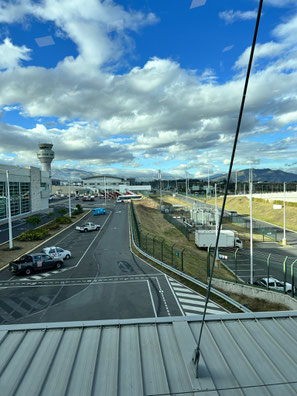
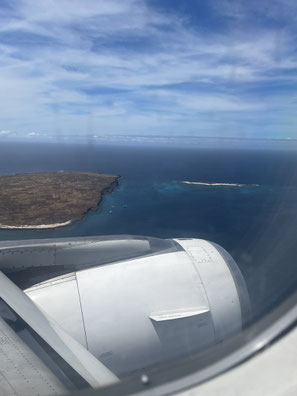
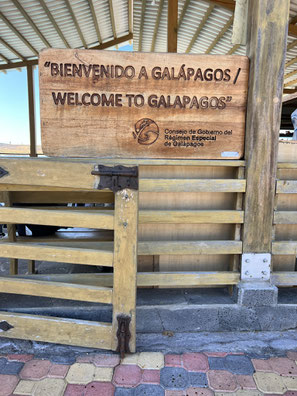
FAQs for Booking Your Travel to the Galapagos
How do I reach the Galapagos Islands?
To reach the Galapagos Islands, you must first fly to mainland Ecuador (either Quito or Guayaquil) and then take a domestic flight to one of the Galapagos airports, located on Baltra or San Cristobal Island; there are no direct international flights to the Galapagos, so you will always need a layover in Ecuador.
Which International Airports are located in mainland Ecuador?
Which Airports are located in the Galapagos Islands?
*GPS is the airport where the dive guides will pick you up at 11:00 am on your liveaboard departure date
- San Cristóbal Airport in Puerto Baquerizo Moreno on San Cristóbal Island (SCY)**
**Would only recommend flying into this airport if the flight options are significantly cheaper, since it requires a two-hour ferry ride from Puerto Ayora in Santa Cruz to Baltra Port (where the liveaboard departs). Additionally, the ferry only operates twice a day, which may require careful scheduling.
***⛴️ Important Note: Seasickness is very common on these ferries due to rough waters, so if you’re prone to motion sickness, be sure to bring medication or take precautions to ensure a more comfortable ride.
Which Airlines Fly from mainland Ecuador to the Galapagos Islands?
*Be sure to check your airline’s baggage restrictions and fees before your trip, as they are strictly enforced.
How long of a stopover do I need in the Quito or Guayaquil Airport before flying to the Galapagos?
You should schedule your flights to include a minimum of a 3 hour layover in Quito or Guayaquil. If possible, it is best to have a 4 hours or more to ensure that you are not stressed and have plenty of time to get your luggage, purchase your transit control card, re-check in for your Galapagos flight, use the rest room, and get some food.
At what time should I plan to arrive in the Galapagos if my flight is landing on the same day that my liveaboard departs?
Passengers scheduled to arrive at Baltra airport (GPS) on the same day as their sailing adventure must ensure that their flight lands no later than 10:30 am (local time).
What is the earliest flight time I can book if I intend to depart on the same day my liveaboard experience concludes?
If you intend to depart on the same day your liveaboard experience concludes, please schedule a flight leaving no earlier than 12:00 noon (local time) from Baltra airport (GPS).
I have an overnight layover in Quito or Guayaquil. Which hotels should I stay in?
We recommend a hotel that is close by the airport to avoid any traffic issues the morning leaving for Galapagos. In Quito the Wyndham Quito airport and in Guayaquil the Wyndham Gardens are both located only 5 minutes away from the airport. We can assist you in your hotel booking.
I will be arriving in the Galapagos Islands before my liveaboard sets sail, or extending my stay afterwards. Which hotels should I stay in?
If you arrive earlier to the islands you will need a hotel in Puerto Ayora. We recommend the Galapagos Suites. The hotel is a family run and offers a high quality standard. It is located in a quiet area of town and still in the middle of the town centre. It is a 5-minute walk from the waterfront as well as a 3-minute walk from the Main Street where you can find many restaurant, tourist informations and other shops. We can assist you with the booking and might be able to arrange a transfer to share with other divers on your liveabord.
Essential Travel Requirements: Fees, Biosecurity & Declarations
The Galapagos Islands are one of the most unique and ecologically sensitive destinations in the world. As a protected national park and home to many endangered species, the Ecuadorian government has implemented strict entry requirements to preserve its delicate ecosystem and promote responsible tourism.
Before you embark on your Galapagos liveaboard adventure, it’s important to familiarize yourself with the following mandatory travel requirements:
✔️ Two required entry fees – the Transit Control Card (TCT) and the National Park Entrance
Fee
✔️ Biosecurity screenings to prevent the introduction of non-native species
✔️ A biosecurity declaration form that must be completed before your flight
✔️ A valid passport, with an expiration date at least six months beyond your expected return to
the U.S.
✔️ If applicable, proof of Yellow Fever vaccination – travelers of any nationality or residency who have spent more than 10 days in transit or visiting Peru, Colombia, Bolivia, or Brazil prior to arriving in Ecuador must present an International Certificate of Vaccination against
Yellow Fever
These measures may seem more extensive than typical travel destinations, but they are essential for protecting the Galapagos and ensuring future generations can experience its incredible biodiversity. We fully support these regulations as part of our commitment to responsible eco-tourism.
✅ Pro tip: Review all requirements carefully before your trip to ensure a smooth arrival and start to your Galapagos journey.
1. Biosecurity Declaration Form
To help protect the fragile ecosystem of the Galapagos Islands, all visitors must now complete the Biosecurity Declaration Form online before their trip.
✅ Submit your Biosecurity Declaration Form online up to 48 hours before your
flight.
✅ Receive a confirmation code via email, which you’ll need to present upon arrival at Baltra or San
Cristóbal Airport.
🌐 Online: Visit declaracion.abgalapagos.gob.ec up to 48 hours before your flight.
📍 At the Airport: Scan the QR code available in Quito or Guayaquil on your flight day.
This paperless system is a major step in preserving Galapagos’ unique biodiversity while making
your travel process smoother!


2. Transit Control Card (TCT) – $20 (Online Purchase Only)
💻 New Process Alert: As of June 2025, the Transit Control Card (TCT) must now be obtained online prior to travel. It will no longer be issued at the airport, a change designed to eliminate long wait times and streamline the entry process for all Galapagos visitors.
What is the TCT?
The TCT is a mandatory requirement for all travelers to the Galapagos Islands. It helps monitor and regulate the flow of visitors in support of conservation efforts. You’ll need to present your TCT during airport check-in and again when entering and leaving the islands.
How to Get Your TCT:
To complete the process, follow these steps:
-
Visit the official TCT registration portal:
🌐 Galapagos Transit Control Card Registration -
Accept the data protection policy and watch the mandatory video on Galapagos entry requirements.
-
Enter your personal information and verify your email with a security code.
-
Provide your travel and accommodation details.
(some ship names differ from their commercial names so if you are traveling with us, please see below)
- Citizen Science Expedition - "Pinguino Explorer"
- Luxury Citizen Science Expedition - "Galaxy diver ii"


5. Accept the liability declaration and proceed with online payment using
a debit or credit card.
💵 Cost: $20 USD
6. After completing payment, click “Reload Page” to download your TCT.
You’ll also receive a copy via email. Be sure to bring a printed or digital copy with you to
the airport.
📌 Reminder: The TCT is essential for boarding your flight to the Galapagos. Airport staff will request to see it at check-in and again upon arrival. Keep your TCT safe throughout your trip, as it will be collected when you depart the islands.
This new digital process supports a more efficient, sustainable, and traveler-friendly experience as you begin your journey to one of the world’s most unique ecosystems.
3. Galapagos Biosecurity Screening
After obtaining your transit control card, proceed to the biosecurity checkpoint. Given that travelers can unintentionally carry seeds or insects, Ecuador has implemented strict biosecurity measures for all air arrivals. At both the Quito and Guayaquil airports, every item of luggage, both checked and hand-carry, will be passed through a biosecurity x-ray screening. Authorities inspect for live animals, plants, and seeds to prevent the introduction of non-native species to the islands. Next you may proceed to the airline check-in counter to check in for your flight.
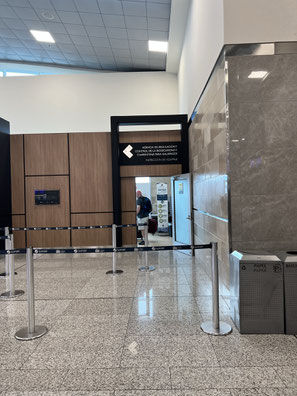
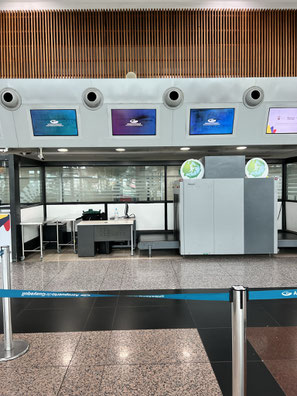
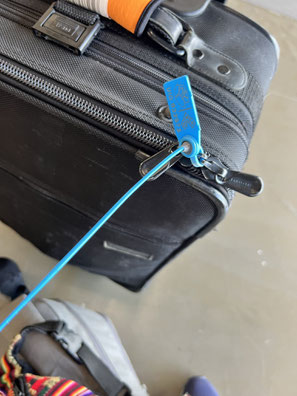
4. Galapagos National Park Entrance Fee – $200 (Cash Only, USD)
💵 Important: Be sure to have $200 USD in cash ready before your arrival, as card payments are not accepted.
Upon arriving in the Galapagos Islands, all tourists are required to pay a Galapagos National Park
entrance fee. The standard rate for foreign visitors aged 12 and older is $200
USD.
How to Pay Your Entrance Fee:
✅ After landing, proceed to the designated payment counter at the airport.
✅ Present your passport and Transit Control Card (TCT) to the official.
✅ Pay the $200 USD cash fee.
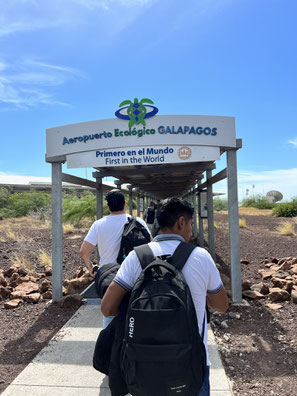


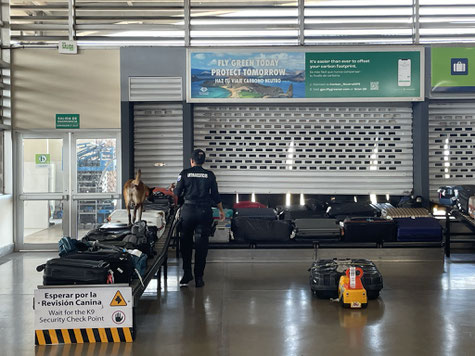
Following this, you'll move to the biocontrol section where you'll present your filled-out affidavit of goods. Your hand luggage will be inspected, after which you can proceed to retrieve your checked baggage. Upon exiting the airport, look for a dive guide holding a sign reading "Aqua", indicating the boat you'll board. This guide will escort you to a bus going to Baltra port. From there, a zodiac/panga boat will ferry you to the liveaboard boat.
If you arrive before your liveaboard's departure date, you can stay in Puerto Ayora. From the airport, two shuttles are available: one heading to Baltra port and the other to the canal Itabaca/town Puerto Ayora. You should board the shuttle going to canal Itabaca. Upon reaching the canal, you'll take a ferry across (note there's only one ferry). From the other side, buses and taxis are available to transport you to Puerto Ayora town. A majority of your co-passengers, around 90%, are likely heading to Puerto Ayora too. On the day your liveaboard sets sail, you should either return to Baltra airport by 11:00 am to join the rest of the group or directly head to Baltra port using a taxi.
If you have questions, please do not hesitate to reach out to us at info@galapagossharkdiving.com.
Related Topics that you might be interested in:
- General tips about the Dive Liveabord
- Tips regarding the water temperature of the Galápagos Islands
- When is the best time to dive in the Galapgaos Islands?
- Tips about right dive equipment









Write a comment